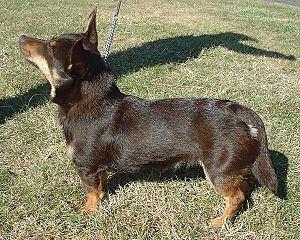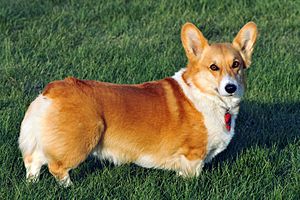Lancashire Heeler facts for kids

Lancashire Heeler at a dog show.
|
||||||||
| Other names | Ormskirk Heeler Ormskirk Terrier |
|||||||
|---|---|---|---|---|---|---|---|---|
| Origin | England | |||||||
|
||||||||
| Domestic dog (Canis lupus familiaris) | ||||||||
The Lancashire Heeler is a small and lively dog breed. People first developed these dogs to help move and look after cattle. They are also known as the Ormskirk Heeler or Ormskirk Terrier.
This breed comes from England. The Kennel Club in the UK lists the Lancashire Heeler as a "vulnerable breed." This means there are not many of them left.
Contents
About the Lancashire Heeler
What They Look Like
Lancashire Heelers have a short, rough, and smooth coat. They also have a soft undercoat that keeps them dry in all kinds of weather. In winter, they might grow a small "mane" around their neck.
Most Lancashire Heelers are black and tan. But some can be liver (a reddish-brown color) and tan. They are a bit longer than they are tall. These dogs usually stand about 25 to 30 centimeters (10 to 12 inches) tall at the shoulder. They weigh around 6 to 8 kilograms (13 to 18 pounds). Their ears can either stand up straight or have tips that fold over.
Their Personality
Lancashire Heelers are very alert and friendly dogs. They are full of energy, smart, and love to play. They make great companions!
Some Heelers might be a bit lazy and playful, while others are very energetic and "talkative." They are strong dogs for their size. They enjoy many activities and can even carry objects as big as themselves. Lancashire Heelers are usually friendly with their owners and people they meet. However, they might be protective of their home if a stranger comes onto their property.
Health and Life
Lancashire Heelers usually live for 12 to 15 years or even longer. Like all breeds, they can have some health issues.
The most common serious problems for Heelers are eye conditions. These include:
- Collie eye anomaly: A problem with the back of the eye.
- Primary lens luxation: When the lens in the eye moves out of place.
- Persistent pupillary membranes: Small strands of tissue in the eye.
They can also sometimes have Patella luxation. This is when the kneecap slips out of place.
History of the Breed
We don't know exactly how the Lancashire Heeler breed started. But it's believed that a type of Welsh Corgi dog was used to move farm animals from Wales to northwest England.
In an area called Ormskirk, a black and tan terrier, similar to the Manchester Terrier, was introduced. Mixing these dogs led to what we now call the Lancashire Heeler. For over 150 years, these dogs were common farm dogs in their home county. They were good at both catching rats and herding cattle.
A woman named Gwen Mackintosh started breeding Heelers in the early 1960s. In 1978, she and other dog lovers created the Lancashire Heeler Club. This club set up a breed standard (rules for what the dog should look like) and a register (a list of all the dogs).
The Kennel Club officially recognized the breed in 1981. Gwen Mackintosh was the club's president until she passed away in 1992.
In 2006, The Kennel Club listed the Lancashire Heeler as a "vulnerable native breed." This means that fewer than 300 puppies are registered each year in the UK. For example, in 2006, 173 Heelers were registered. In 2007, this number dropped to 146. In 2016, a big international dog organization called the FCI also added the breed to its list of accepted breeds.
Fun Activities for Heelers
Lancashire Heelers are very active and smart dogs. They can take part in many fun dog sports and activities, such as:
- Dog agility: Running through obstacle courses.
- Obedience: Following commands and showing good manners.
- Rally obedience: A fun way to practice obedience commands.
- Dog showmanship: Showing off their best qualities in dog shows.
- Flyball: A relay race where dogs jump hurdles and fetch a ball.
- Herding events: Showing off their natural ability to herd animals.
Dogs that show basic herding instincts can even be trained to compete in special herding trials.
See also
 In Spanish: Lancashire Heeler para niños
In Spanish: Lancashire Heeler para niños



